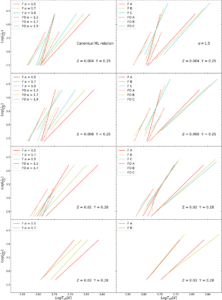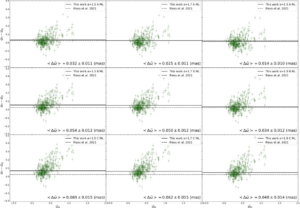First we plan to measure TRGB using Gaia EDR3 with an enlarged sample with |b| > 10◦. We work in Cousins I magnitudes, obtained from SkyMapper & PanSTARRS iPSF by a zeropoint offset described by Mould,Clementini&DaCosta, for which we shall improve the precision. The I magnitudes are corrected for extinction by a few hundredths of a magnitude for |b| > 20◦ and up to 0.1 mag for 10◦ < |b| < 20◦, using maps by Schlegel et al. (1998). While Cousins I is a good choice of photometric bandpass because the bolometric correction is a slow function of temperature at the temperatures of red giant stars, we may also investigate TRGB (bolometric) and compare with theory. Near infrared photometry from the 2MASS survey (Skrutskie et al 2006) is useful for this purpose. MCD used the Trilegal model of Girardi for bias correction and this will be an interesting area for ISSI project interaction and collaboration.
– Jensen, J. …, MOULD, J., et al. 2024, “The JWST SBF Coma Cluster Survey: Building an Alternative Precision Distance Ladder for Cosmology”, JWST Proposal. Cycle 3, ID. #5989 (February 2024)
Mariateresa Crosta (INAF-OATo Osservatorio Astrofisico di Torino)
My contribution to ISSI 2020 will focus on the evaluation of the Gaia absolute parallaxes as derived with the astrometric general relativistic models available, in particular those adopted in the Gaia Data Processing and Analysis Consortium (DPAC) for the next releases and for the related astrometric verifications. In fact, Gaia parallaxes are derived via a complex block-iterative solution of a relativistic model accurate at ~ 1 µas, along with instrumental, global, and astrometric parameters.
However, this procedure may lack of the gradual implementation of different degrees of complexity since one has to take into account many tiny relativistic effects due to the non-linear overlapping of the local gravitational fields in the Solar system that affects light propagation at the sub-muas accuracy. For this reason alternative relativistic models are currently implemented for the Gaia astrometric processing and their cross-validation is mandatory to avoid residual systematic errors in parallaxes.
Then, the goals are: (i) to investigate if systematics or any other residuals can influence the parallax determination by comparing or extending to higher accuracies such models, (ii) to check if the actual definition of distance as well as the redshift determination is suitable for the actual level of accuracy or more accurate GR modelling is needed to complete the error budget, (iii) in such a case, to verify if new GR relativistic effects could play a role in the origin/solution of the H0 tension or constitutes a new independent verification, and (iv) possibly, to bridge the local definition of luminosity distance with the cosmological one.
For all of these aspects specific collaborations with colleagues expert in astrometric parallaxes reconstructions and related problems (i.e., parallax zero point, statistical uncertainties) already involved in DPAC is mandatory. Moreover also colleagues from the cosmology domain will be involved in regard to LCDM model to provide, finally, a consistent GR formulation of the various distances.
The computations of nonlinear convective pulsation models for different classes of pulsating stars allowed us to derive new theoretical relations in selected photometric filters to be used in cosmic distance scale applications.
In particular we built a new theoretical scenario for Classical Cepheids varying the chemical composition, the Mass-Luminosity relation and the efficiency of super-adiabatic convection and were able to discuss the implications for the calibration of the cosmic distance scale (De Somma et al. 2022). We also performed an accurate investigation of the Hertzsprung progression phenomenon for the so-called bump Cepheids (Marconi et al. 2024).
For both Classical Cepheids and RR Lyrae we transformed the predicted pulsation properties into the Rubin-LSST filters thus obtaining relevant relations and extensive model databases to be applied to the future observed samples (De Somma et al. 2024, Marconi et al. 2022).


Improving Gaia zero point offset determination and characterization of standard candles for Gaia DR4 and DR5”
– Standard candles task force in the Gaia DPAC
– Specific processing and characterization of DR4 RR Lyrae stars and Cepheids
